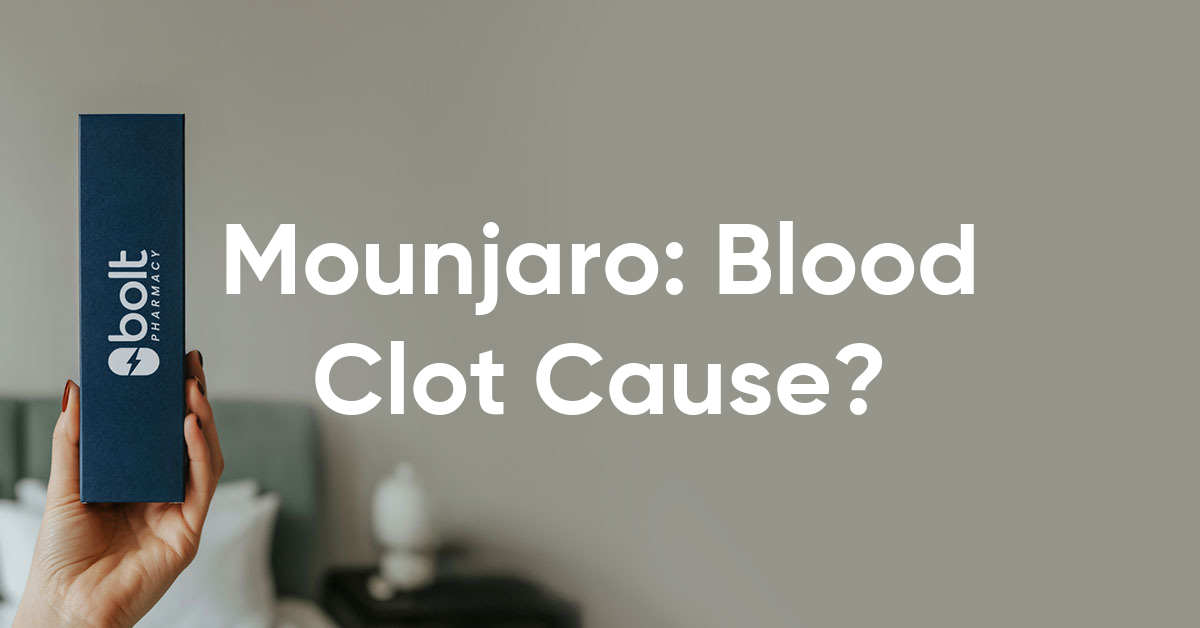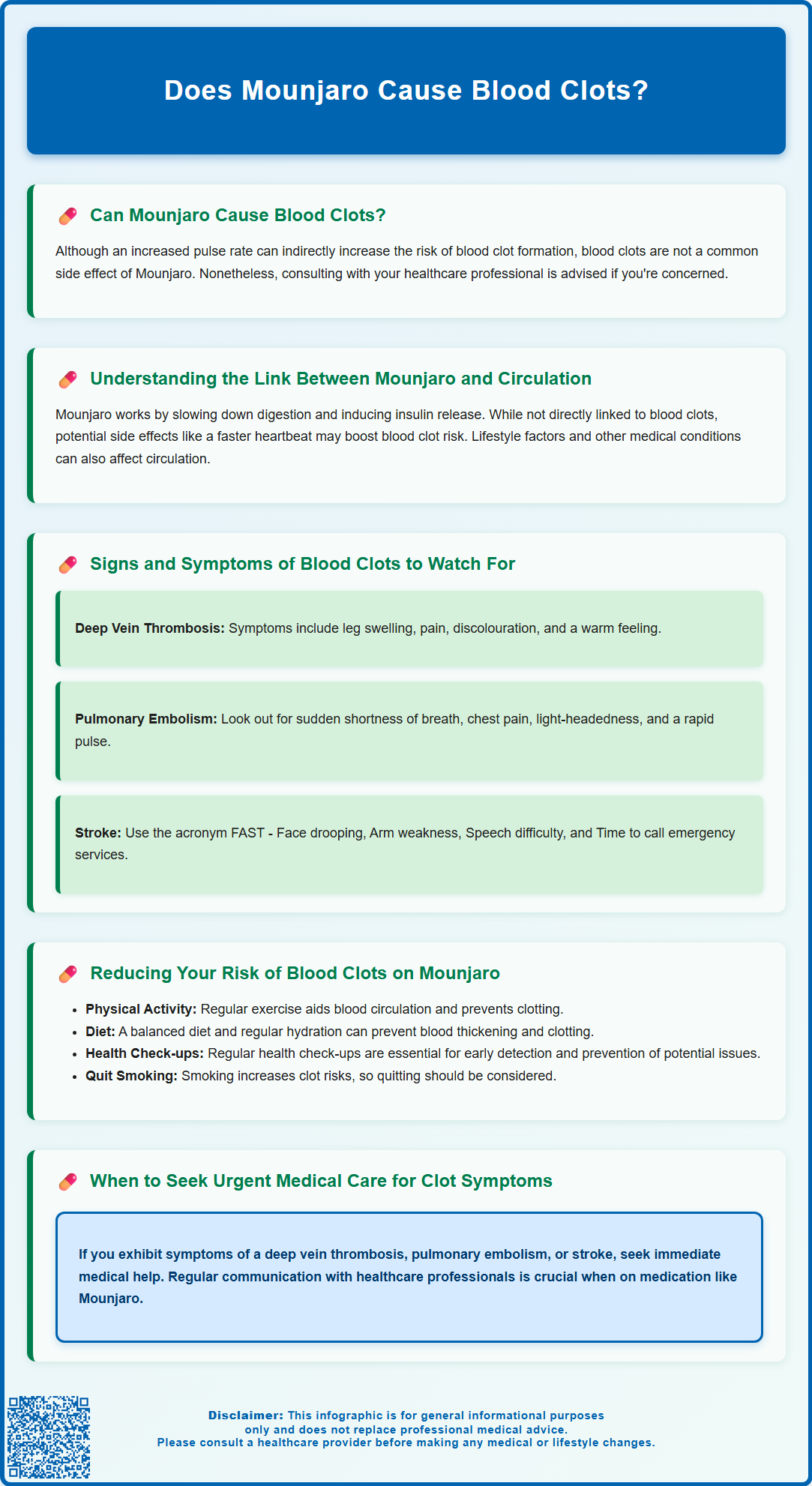
Mounjaro (tirzepatide) is a dual GIP and GLP-1 receptor agonist licensed in the UK for managing type 2 diabetes mellitus. As with any medication, patients may have concerns about potential side effects, including whether Mounjaro causes blood clots. Understanding the evidence-based safety profile of tirzepatide is essential for informed decision-making. This article examines the current clinical evidence regarding Mounjaro and blood clot risk, reviews recognised side effects, and provides guidance on when to seek medical advice, all in accordance with UK regulatory standards and clinical guidelines.
Summary: There is no established clinical evidence linking Mounjaro (tirzepatide) to an increased risk of blood clots or venous thromboembolism.
Mounjaro is the brand name for tirzepatide, a prescription medicine licensed in the United Kingdom as an adjunct to diet and exercise for the treatment of adults with type 2 diabetes mellitus. It was approved by the Medicines and Healthcare products Regulatory Agency (MHRA) following extensive clinical trials demonstrating its efficacy in improving glycaemic control. Mounjaro belongs to a novel class of medications that work through a dual mechanism, making it distinct from many other diabetes treatments currently available.
Tirzepatide functions as a dual glucose-dependent insulinotropic polypeptide (GIP) and glucagon-like peptide-1 (GLP-1) receptor agonist. This means it activates two separate hormone receptors that play important roles in regulating blood glucose levels. When blood sugar rises after eating, Mounjaro stimulates the pancreas to release insulin in a glucose-dependent manner, which helps lower blood glucose levels. Simultaneously, it suppresses the release of glucagon, a hormone that raises blood sugar. The medication also slows gastric emptying, which moderates the rate at which glucose enters the bloodstream after meals.
Beyond its glucose-lowering effects, Mounjaro influences appetite regulation through actions in the central nervous system, leading to reduced food intake and subsequent weight loss in many patients. While weight reduction is a beneficial effect in type 2 diabetes management, it's important to note that Mounjaro is specifically licensed for diabetes treatment in the UK, not as a weight management medication. Mounjaro is administered once weekly via subcutaneous injection, typically in the abdomen, thigh, or upper arm. The dosage starts at 2.5 mg once weekly for 4 weeks, then increases in 2.5 mg increments as tolerated to reach the target dose. This gradual titration helps minimise gastrointestinal side effects and optimise therapeutic response. As with all prescription medications, Mounjaro should only be used under the supervision of a qualified healthcare professional who can monitor its effects and adjust treatment as necessary.

As of April 2024, there is no established clinical evidence linking Mounjaro (tirzepatide) directly to an increased risk of blood clots or venous thromboembolism. The extensive clinical trial programme that supported Mounjaro's regulatory approval, including the SURPASS series of studies involving thousands of participants, did not identify blood clots as a recognised adverse effect of the medication. The Summary of Product Characteristics (SmPC) approved by the MHRA does not list thrombotic events among the known side effects of tirzepatide.
It is important to distinguish between a medication causing a side effect and coincidental events that may occur in patients taking that medication. Type 2 diabetes itself is associated with an increased risk of cardiovascular complications, including thrombotic events, due to factors such as endothelial dysfunction, increased platelet reactivity, and chronic inflammation. Patients with type 2 diabetes often have multiple cardiovascular risk factors, including obesity, hypertension, and dyslipidaemia, which independently contribute to thrombotic risk. Therefore, any thrombotic events occurring in patients taking Mounjaro may be related to their underlying condition rather than the medication itself.
The European Medicines Agency (EMA) and MHRA continuously monitor the safety profile of all licensed medications through pharmacovigilance systems. Healthcare professionals and patients are encouraged to report any suspected adverse reactions through the Yellow Card Scheme (yellowcard.mhra.gov.uk), which helps identify previously unrecognised safety signals. To date, regulatory authorities have not issued warnings regarding blood clots and tirzepatide. If you have concerns about blood clots whilst taking Mounjaro, it is essential to discuss these with your GP or diabetes specialist, who can assess your individual risk factors and provide personalised advice. Clinical decisions should always be based on the balance of benefits and risks for each patient, taking into account their complete medical history and current health status.
Mounjaro has a well-characterised safety profile based on clinical trial data and post-marketing surveillance. The most commonly reported side effects are gastrointestinal in nature, reflecting the medication's mechanism of action on the digestive system. These include nausea, diarrhoea, vomiting, constipation, abdominal pain, and reduced appetite. These symptoms are typically mild to moderate in severity and tend to diminish over time as the body adjusts to the medication. Starting at a lower dose and gradually increasing it, as recommended in the prescribing information, helps minimise these gastrointestinal effects.
The gastrointestinal side effects can potentially lead to dehydration, which may increase the risk of acute kidney injury in susceptible individuals. Patients should be advised to maintain adequate fluid intake, particularly if experiencing vomiting or diarrhoea, and to seek medical advice if symptoms are severe or persistent. Renal function should be monitored as clinically indicated, especially in those with pre-existing kidney disease.
Hypoglycaemia (low blood sugar) can occur with Mounjaro, particularly when it is used in combination with other glucose-lowering medications such as sulphonylureas or insulin. When used as monotherapy or with metformin, the risk of hypoglycaemia is generally low due to the glucose-dependent mechanism of action. Dose reductions of insulin or sulphonylureas may be necessary when initiating Mounjaro. Patients should be educated about recognising symptoms of hypoglycaemia, including trembling, sweating, confusion, palpitations, and hunger, and know how to treat it promptly with fast-acting carbohydrates.
Rapid improvement in blood glucose control may be associated with temporary worsening of diabetic retinopathy. Patients with a history of diabetic retinopathy should be monitored appropriately when starting Mounjaro treatment.
Other recognised adverse effects include injection site reactions, fatigue, and increased heart rate. Rare but serious potential risks include pancreatitis (inflammation of the pancreas), which presents with severe persistent abdominal pain that may radiate to the back, often accompanied by vomiting. Patients experiencing such symptoms should seek immediate medical attention. In rodent studies, tirzepatide caused C-cell tumours, but the relevance to humans is unknown. Clinical monitoring should follow SmPC recommendations.
Gallbladder problems, including cholelithiasis (gallstones) and cholecystitis (gallbladder inflammation), have been reported with GLP-1 receptor agonists, likely related to rapid weight loss. Patients should be advised to report symptoms such as right upper abdominal pain, particularly after eating fatty meals.
Importantly, tirzepatide can reduce the exposure to oral contraceptives after initiation and dose escalation. Women using oral contraceptives should consider using non-oral contraceptives or adding a barrier method for 4 weeks after starting Mounjaro and after each dose increase. Regular monitoring by healthcare professionals ensures the safe and effective use of Mounjaro throughout treatment.
Understanding the risk factors for blood clots is important for all patients, particularly those with type 2 diabetes who may have multiple cardiovascular risk factors. Venous thromboembolism, which includes deep vein thrombosis (DVT) and pulmonary embolism (PE), can occur due to various predisposing factors. These include prolonged immobility, recent surgery, active cancer, pregnancy, use of combined hormonal contraceptives or hormone replacement therapy, previous history of blood clots, inherited thrombophilias, obesity, smoking, and increasing age. Type 2 diabetes itself is considered a prothrombotic state due to metabolic abnormalities that affect blood vessel function and clotting mechanisms.
Patients should be aware of the warning signs of blood clots and seek immediate medical attention if they develop symptoms suggestive of DVT or PE. Deep vein thrombosis typically presents with pain, swelling, warmth, and redness in one leg, most commonly the calf or thigh. The affected limb may feel heavy or tender to touch. Pulmonary embolism, which occurs when a clot travels to the lungs, is a medical emergency characterised by sudden onset of breathlessness, sharp chest pain that worsens with deep breathing, rapid heart rate, coughing (sometimes with blood-stained sputum), and feeling faint or dizzy. Anyone experiencing these symptoms should call 999 or attend the nearest accident and emergency department immediately. Further information on symptoms and management can be found on the NHS website pages for DVT and pulmonary embolism.
NICE guidance (NG158 on venous thromboembolic diseases and NG89 on reducing hospital-acquired VTE) emphasises the importance of risk assessment for venous thromboembolism in all patients, particularly those with multiple risk factors or undergoing procedures that increase thrombotic risk. Patients taking Mounjaro who require hospitalisation or surgery should inform their healthcare team about their medication, as temporary adjustments may be necessary according to local anaesthesia and surgical policies. Maintaining mobility, staying well hydrated, and managing modifiable risk factors such as weight and smoking can help reduce overall thrombotic risk.
If you have concerns about blood clots whilst taking Mounjaro, discuss these with your GP or diabetes specialist. They can assess your individual risk profile, review your medications, and determine whether any additional preventive measures or investigations are warranted. It is important not to stop taking prescribed medications without medical advice, as this could adversely affect your diabetes control. Open communication with your healthcare team ensures that any concerns are addressed appropriately and that your treatment plan remains safe and effective for your individual circumstances.
No, there is currently no established clinical evidence linking Mounjaro (tirzepatide) to an increased risk of blood clots. The extensive SURPASS clinical trial programme and MHRA-approved prescribing information do not identify thrombotic events as a recognised side effect of tirzepatide.
The most common side effects of Mounjaro are gastrointestinal, including nausea, diarrhoea, vomiting, constipation, and abdominal pain. These symptoms are typically mild to moderate and tend to improve over time, especially with gradual dose titration as recommended.
Seek immediate medical attention if you experience symptoms of deep vein thrombosis (leg pain, swelling, warmth, redness) or pulmonary embolism (sudden breathlessness, sharp chest pain, rapid heart rate, coughing blood). Call 999 or attend A&E immediately if these symptoms occur.
The health-related content published on this site is based on credible scientific sources and is periodically reviewed to ensure accuracy and relevance. Although we aim to reflect the most current medical knowledge, the material is meant for general education and awareness only.
The information on this site is not a substitute for professional medical advice. For any health concerns, please speak with a qualified medical professional. By using this information, you acknowledge responsibility for any decisions made and understand we are not liable for any consequences that may result.
Lorem ipsum dolor sit amet, consectetur adipiscing elit, sed do eiusmod tempor incididunt ut labore et dolore magna aliqua. Ut enim ad minim veniam, quis nostrud exercitation ullamco laboris nisi ut aliquip ex ea commodo consequat. Duis aute irure dolor in reprehenderit in voluptate velit esse cillum dolore eu fugiat nulla pariatur.
Block quote
Ordered list
Unordered list
Bold text
Emphasis
Superscript
Subscript